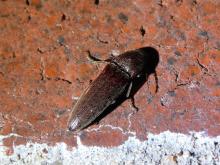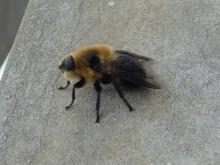Land Invertebrates
Media

Species Types
Scientific Name
Approximately 1,000 species in North America
Description
Their streamlined shape is distinctive, but the behavior of click beetles is even more unique: Placed on their backs, these beetles flip suddenly into the air with an audible click.
Media

Species Types
Scientific Name
Tabanus, Chrysops, and related genera
Description
Meet the horse fly: Stealthily, one will land on your back, slice your skin, and lap your blood. By the time it starts to hurt and you swat at it, the painful, itchy welt is rising.
Media

Species Types
Scientific Name
Sphex pensylvanicus
Description
A strikingly large black wasp with smoky black wings that shine with blue iridescence, the great black wasp is often seen busily eating nectar and pollen from flowers in summertime.
Media

Species Types
Scientific Name
Nearly 500 species in North America north of Mexico
Description
Soldier beetles are most often seen on flowers. Many species in this family are pollinators. Yellow, orange, and red are their most common colors, besides black and brown.
Media

Species Types
Scientific Name
About 85 species in North America north of Mexico
Description
Green lacewings are delicate insects whose larvae are ravenous predators of aphids. This makes the lacewing a friend to gardeners!
Media

Species Types
Scientific Name
Scudderia furcata
Description
The fork-tailed bush katydid reaches about 1¾ inches long. It is usually leafy green and is most common in bushes, thickets, and other shrubby areas. It is most active after dusk. The call is a simple "tsip!" given every few seconds.
Media

Species Types
Scientific Name
About 40 species in North America north of Mexico
Description
Bot flies are chunky, beelike flies usually with rounded heads. Adults are not commonly seen. The larvae are short, pudgy, segmented grubs that live as parasites in the tissues of animals. Those that live just under the skin often form a bulge. Some types live in the nasal or throat cavities of deer.
Media

Species Types
Scientific Name
8 tribes, with about 23 genera, in North America north of Mexico
Description
Millipedes in family Xystodesmidae often have bright colors that serve as a warning to potential predators that they may secrete foul or toxic substances.
Media

Species Types
Scientific Name
Poecilopompilus algidus and P. interruptus
Description
Poecilopompilus spider wasps provision their nests with orbweaver spiders. They dig nest burrows into the ground and therefore prefer sandy or other workable substrates.
Media

Species Types
Scientific Name
Entypus aratus, E. unifasciatus, E. fulvicornis, and others
Description
Spider wasps in genus Entypus are bluish black and usually have some amount of amber color on their dark, smoky wings. Some species have bright yellow antennae.
See Also



Media

Species Types
Scientific Name
Cisseps fulvicollis
Description
The yellow-collared scape moth is more often “orange-collared.” And whether you think it looks more like a firefly or a wasp, it’s still a moth!
Media

Species Types
Scientific Name
Nearly 150 species in North America north of Mexico
Description
Slim, delicate plume moths are instantly recognizable by their T-shaped silhouette, long legs, and muted shades of tan and brown. It can be hard to separate the various species.
Media

Species Types
Scientific Name
Pyrrharctia isabella
Description
Not many people know the adult Isabella tiger moth when they see one, but we’re all acquainted with its caterpillar, the woolly worm, or woolly bear.
About Land Invertebrates in Missouri
Invertebrates are animals without backbones, including earthworms, slugs, snails, and arthropods. Arthropods—invertebrates with “jointed legs” — are a group of invertebrates that includes crayfish, shrimp, millipedes, centipedes, mites, spiders, and insects. There may be as many as 10 million species of insects alive on earth today, and they probably constitute more than 90 percent all animal species.





















